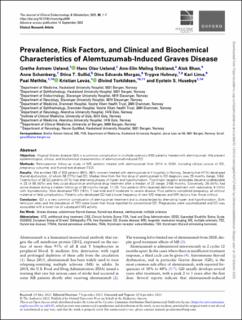Prevalence, Risk Factors, and Clinical and Biochemical Characteristics of Alemtuzumab-Induced Graves Disease
Ueland, Grethe Åstrøm; Ueland, Hans Olav; Stokland, Ann-Elin Meling; Bhan, Alok; Schønberg, Anne; Sollid, Stina Therese; Morgas, Dina Edvarda; Holmøy, Trygve; Lima, Kari; Methlie, Paal; Løvås, Kristian; Torkildsen, Øivind; Husebye, Eystein Sverre
Journal article, Peer reviewed
Published version

Åpne
Permanent lenke
https://hdl.handle.net/11250/3117053Utgivelsesdato
2024Metadata
Vis full innførselSamlinger
- Department of Clinical Medicine [2066]
- Registrations from Cristin [9791]
Originalversjon
Journal of Clinical Endocrinology and Metabolism (JCEM). 2024, 109, 344–350. 10.1210/clinem/dgad540Sammendrag
Objective
Atypical Graves disease (GD) is a common complication in multiple sclerosis (MS) patients treated with alemtuzumab. We present epidemiological, clinical, and biochemical characteristics of alemtuzumab-induced GD.
Methods
Retrospective follow-up study of MS patients treated with alemtuzumab from 2014 to 2020, including clinical course of GD, pregnancy outcome, and thyroid eye disease (TED).
Results
We enrolled 183 of 203 patients (90%, 68% women) treated with alemtuzumab at 4 hospitals in Norway. Seventy-five (41%) developed thyroid dysfunction, of whom 58 (77%) had GD. Median time from the first dose of alemtuzumab to GD diagnosis was 25 months (range, 0-64). Twenty-four of 58 GD patients (41%) had alternating phases of hyper- and hypothyroidism. Thyrotropin receptor antibodies became undetectable in 23 of 58 (40%) and they could discontinue antithyroid drug treatment after a median of 22 (range, 2-58) months. Conversely, 26 (44%) had active disease during a median follow-up of 39 months (range, 11-72). Two patients (3%) received definitive treatment with radioiodine, 6 (10%) with thyroidectomy. Nine developed TED (16%), 7 had mild and 2 moderate to severe disease. Four patients completed pregnancy, all without maternal or fetal complications. Patients who developed GD had a lower frequency of new MS relapses and MRI lesions than those without.
Conclusion
GD is a very common complication of alemtuzumab treatment and is characterized by alternating hyper- and hypothyroidism. Both remission rates and the prevalence of TED were lower than those reported for conventional GD. Pregnancies were uncomplicated and GD was associated with a lower risk of subsequent MS activity.
